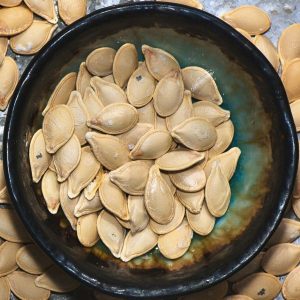Carved pumpkins look their best one to two days after carving and rarely look good after seven days.
 Pumpkins begin decomposing from harmless bacteria and fungi in the air and on the carver’s hands. To avoid transferring bacteria to the pumpkin, first wash your hands well with soap and water or clean with a hand sanitizer. You’ll also want to make sure your carving tools are clean. Then wipe down the outside of the pumpkin with a 10% bleach solution before making the first cut.
Pumpkins begin decomposing from harmless bacteria and fungi in the air and on the carver’s hands. To avoid transferring bacteria to the pumpkin, first wash your hands well with soap and water or clean with a hand sanitizer. You’ll also want to make sure your carving tools are clean. Then wipe down the outside of the pumpkin with a 10% bleach solution before making the first cut.
Once carved, you can keep your pumpkin fresh for up to a week by daily wiping the inside and cut areas with bleach or spraying with a household cleaning spray that includes bleach. Be sure to keep the liquid from pooling in the bottom of or under your pumpkin as this can induce speed-rot. Then give those areas a thin coating of petroleum jelly for extra protection.
Carved pumpkins decline fastest in warm weather. So it’s best to keep them out of direct sunlight and when temperatures exceed 70°F move them into a garage, cool basement, or a refrigerator. If it rains, you should dry off and refrigerate your carved pumpkins at night. Freezing temperatures also speed decay, so move them to a protected location when temperatures outside are below 32oF.
If a pumpkin starts to shrivel or get moldy prematurely, revive it by soaking it in a bucket of water with a disinfecting solution of two teaspoons of bleach for every gallon of water. To light up your carved pumpkin for more than one night, use a battery-operated ‘candle’ or small flashlight instead of a wax candle. This will prevent soot and heat damage that will shorten the pumpkin’s viable good looks.
Save your plants? Bring them indoors!
If you want to salvage some of your outdoor container flowers, bring them inside right away. Making this move takes time and energy, but with just a little planning, your plants will provide winter-long enjoyment indoors, thrive in good health, and be ready for their move back to the patio come spring. Here are the simple actions that will get your container plants ready to “winter over” successfully:
The Big Cut – This is the time to give these container plants their fall haircuts. Prune off dead flowers, yellowed leaves, and anything else you consider unsightly. Use a few more snips to give shape and balance to the remaining foliage. This cosmetic touch-up allows for maximum air circulation that reduces debilitating bacterial and fungal growths. This is not a buzz cut, only a trim; so leave on lots of the green leaves.
Give them the Big Flush – Our local water contains a good deal of unwanted salt and minerals that build up in the potting soil and on the containers. Flush each plant with at least a gallon of water until the water is flowing freely from the bottom of the container. This generous watering also will drown and flush away unwanted insects living in the soil, so flush, flush, flush!
A Clean Affair – Take a few minutes to clean up the outsides of the containers. Wash and brush off mineral residue, debris, and dirty spots that have collected on the pots. Spray dulled terra-cotta clay pots with cooking oil to restore their vibrancy. Less than pristine containers are common and acceptable on a patio, but not welcomed in a living room.
 Don’t Bug Me – Bugs can be flushed out of the soil but the insects’ eggs might remain and the warmer indoor temperatures will cause eggs to hatch right away, rewarding you with huge indoor colonies of aphids, earwigs, spiders, mealy bugs, and fungus gnats. To head off these unwanted plant squatters, spray them with all natural “Home Harvest” bug control. Saturate the stems, foliage, and base of each plant with this organic spray. It not only kills unwanted pests, but has a natural residual repellent effect as well.
Don’t Bug Me – Bugs can be flushed out of the soil but the insects’ eggs might remain and the warmer indoor temperatures will cause eggs to hatch right away, rewarding you with huge indoor colonies of aphids, earwigs, spiders, mealy bugs, and fungus gnats. To head off these unwanted plant squatters, spray them with all natural “Home Harvest” bug control. Saturate the stems, foliage, and base of each plant with this organic spray. It not only kills unwanted pests, but has a natural residual repellent effect as well.
Soil Insects Gone – Having groomed the plants and flushed their soil, the next step is contending with those worm-like insects that remain alive and thriving in the soil. Most of these insects will eat the roots off plants causing severe damage by late winter. A couple of days before making the move indoors be sure to apply Bonide’s “Systemic Houseplant Insect Control” to each container. Then lightly water each treated plant; this will release the granular insecticide, easily exterminating soil-loving insects.
A New Container – Finally, this is the time to consider repotting. If plants have been hard to keep watered, or the roots noticeably spiral around or bunch up in the container, it is time to repot. Keep in mind that whether new pots or same pots, plants always appreciate some fresh potting soil.
Until next week, I’ll see you at the garden center.
Ken Lain can be found throughout the week at Watters Garden Center, 1815 W. Iron Springs Rd in Prescott, or contacted through his web site at www.wattersgardencenter.com or Facebook page www.facebook.com/WattersGardenCenter

